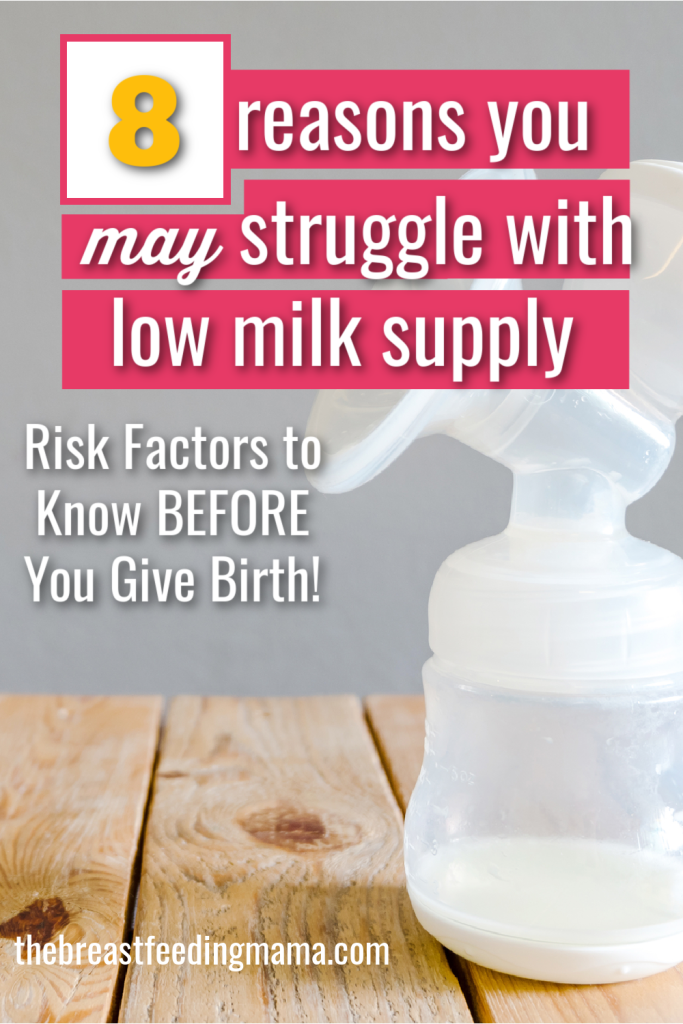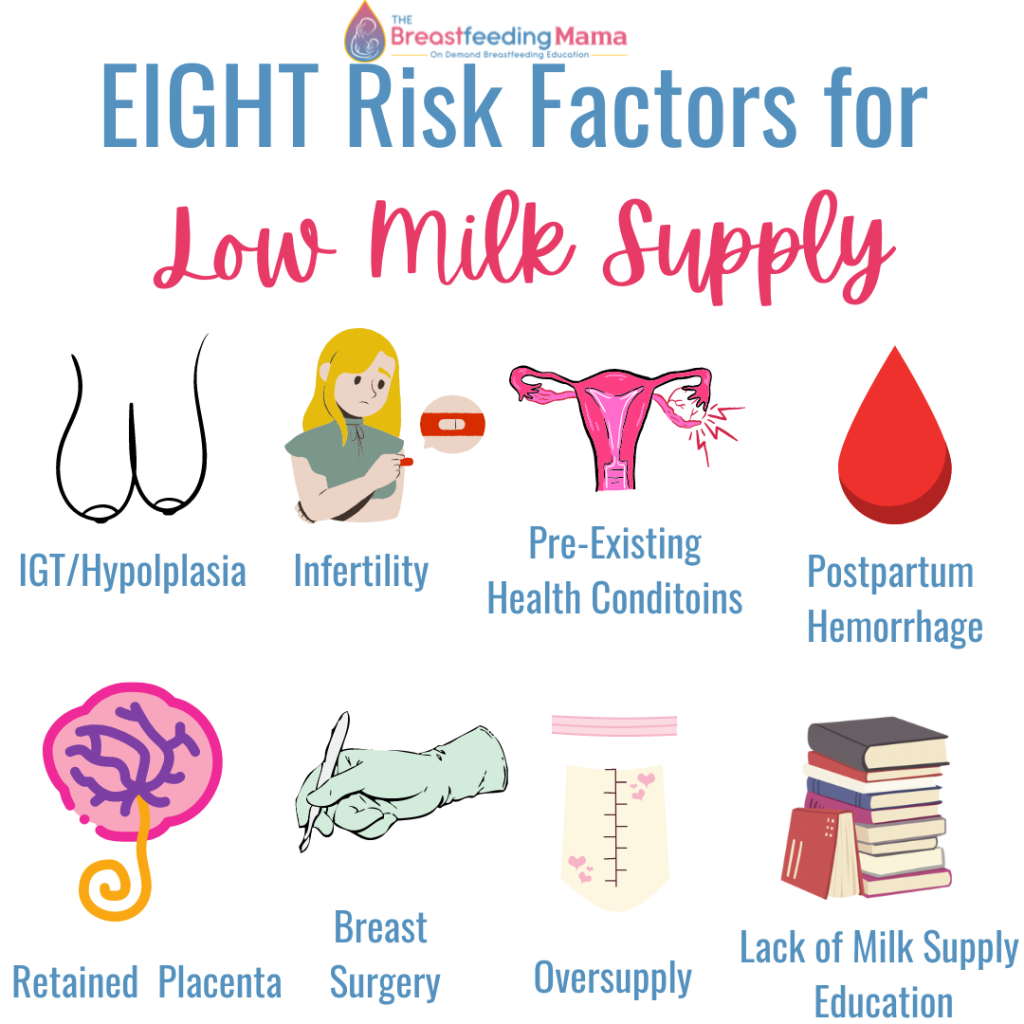Low milk supply affects thousands of women throughout the world. While some factors are in your control, not all of them are. In this article, you will learn from an IBCLC about seven potential risk factors for struggling with low milk supply – and what you can do about it.

As a new mother, the prospect of nourishing your little one with the incredible gift of breast milk is undoubtedly a cherished goal. Breastfeeding is a beautiful and natural way to bond with your baby while providing them with essential nutrients and antibodies. However, for some mothers, the journey towards successful breastfeeding may present unexpected challenges, and one of the most common concerns is low milk supply.
Let’s uncover the mystery behind low milk supply and discover the various factors that could impact your breastfeeding journey. Whether you’re an expectant mother preparing for the arrival of your little one or already on the breastfeeding path, this guide will equip you with valuable knowledge and insights to navigate any potential hurdles you might encounter along the way.

One – Insufficient Glandular Tissue (IGT)
You may have heard stories about mothers whose milk supply flows effortlessly, but for some women with Insufficient Glandular Tissue (IGT), this might not be the case.
IGT is a condition where breast development during puberty and pregnancy is limited, resulting in fewer milk-producing glands. As a result, your milk supply may be lower than what your baby needs.
There are various reasons why a woman may experience IGT or hypoplastic breasts – many of which are related to hormonal or endocrine disorders.
Some of the signs of IGT include:
- Breast asymmetry – this is when one breast is significantly larger than the other
- Absence of breast growth during puberty and/or pregnancy
- Tubular breast shape
- Bulbous areola
Traditional methods for increasing milk supply may prove fruitless for those with IGT.
Small breast size does not necessarily mean you have IGT.
There is no easy solution to insufficient glandular tissue. Knowing that you have it can help you prepare for supplementing options (such as a Supplemental Nursing System), set up realistic expectations, and can help prevent you from spending time, money, and energy trying to increase your supply.
Two – Past Infertility or Fertility Issues
You may have struggled with fertility issues before conceiving your baby – and that can feel unfair enough. Unfortunately, those who struggle with fertility issues may be at a higher risk of struggling with the primary causes of low milk supply.
Women who undergo fertility treatments or have a history of infertility may find that hormonal imbalances from those experiences can affect milk production. Some research has shown that women who experience a luteal phase defect may also struggle to breastfeed and are at a higher risk of IGT.
If you struggled to get pregnant, here are a few suggestions:
- Try and identify the cause of your infertility, and if it’s hormonally related
- Initiate breastfeeding early and frequently
- Determine if there are medications that may help your condition and that are compatible with breastfeeding
- Book a prenatal consult to go over your past history – when I do a consult about low milk supply, I provide my clients with a list of blood tests that may help determine low milk supply.
Three – Pre-Existing Health Conditions
Certain medical conditions can interfere with lactation. Here are a few that may cause issues:
- Polycystic Ovarian Syndrome (PCOS) – This condition can promote low progesterone levels during puberty and pregnancy, which can lead to issues such as IGT.
- Thyroid Disorders
- Type I Diabetes
Irregular hormone levels may disrupt the stimulation of milk production or even inhibit it altogether.
If you suspect you have an underlying hormonal or other medical condition that could impact breastfeeding, it can be valuable to work with a lactation consultant and other healthcare providers before you give birth.
Four – Postpartum Hemorrhage and Postpartum Challenges
Experiencing a significant postpartum hemorrhage can be a physically and emotionally draining event. If you had severe bleeding during or after childbirth, it might impact your body’s ability to produce breast milk initially.
Your body requires time to recover and rebuild its strength, and this may delay the onset of lactation. Research shows that “following a significant PPH, women with greater blood loss are less likely to initiate and sustain full breastfeeding and this may be related, in part, to delays in initial contact with their baby as a consequence of the PPH.”
Other reasons why postpartum hemorrhage may cause issues include:
- Maternal fatigue
- Traumatic birth and maternal stress may interfere with the typical course of lactogenesis II
- The blood loss may lead to ischemia of the pituitary gland, where prolactin is released. Prolactin stimulates milk production and if these levels are altered, it may lead to milk supply issues
In these situations, post-natal care is essential, as you may need extra assistance with feeding and caring for your child. Obviously, you really can’t predict
Five – Retained Placenta
A retained placenta occurs when fragments of the placenta remain in the uterus after childbirth. When the placenta isn’t entirely removed from the uterus, the body may not trigger the hormones needed to start producing larger quantities of breast milk.
This condition can lead to postpartum hemorrhage and other complications, affecting the early initiation of breastfeeding.
If you are several days or even a few weeks into breastfeeding and you have noticed your milk supply has never fully come in – and there are no other explanations – it is worth talking with your provider about the possibility of a retained placenta. While this typically doesn’t go unnoticed, it sometimes does.
Six – Past Breast Surgery
Women who have undergone breast surgery, such as breast augmentation or reduction, may encounter breastfeeding difficulties. Surgical procedures involving the breast tissue or nipple can disrupt milk ducts and nerves, impacting milk supply and the ability to latch effectively.
However, not all breast surgeries automatically result in breastfeeding obstacles. Some women can still breastfeed with some guidance and support. Consulting with a lactation consultant before giving birth can help you better understand potential challenges and explore alternative feeding methods if necessary.
I have also seen women who have had breast surgery, and because of the scar tissue, they have had recurrent clogged ducts and mastitis.
If you are planning to get breast surgery, it’s important to tell the surgeon ahead of time of your desire to breastfeed future children. Often, they can take extra care to preserve milk ducts.
BFAR.org is a fantastic resource for women who have undergone breast surgery and would like to breastfeed.
Seven – Perceived Milk Supply
The perception of inadequate milk supply is a common concern among new mothers. Feeling like you are not producing enough milk for your baby can lead to anxiety and self-doubt.
However, it’s essential to distinguish between perceived and actual milk supply issues. Most women can produce sufficient milk for their babies, but factors like a baby’s growth spurts, feeding patterns, and baby’s behavior can give the illusion of a low milk supply.
Sometimes when you have perceived milk supply issues, it can lead to actual milk supply issues because it may cause you to nurse or pump less than you might have otherwise.
Eight – Oversupply
But…we’re talking about low milk supply, right?! Why is an oversupply on this list.
Over the past eight years as I’ve worked with breastfeeding mothers, I have seen a large number of these women who struggle with oversupply end up having low milk supply later.
There are various reasons for this, but I believe the most common reason is that, when milk supply is plentiful, it can be easy to nurse less frequently – which leads to less stimulation of the breast. Milk supply can start to regulate, and if the body isn’t getting the stimulation it needs to recognize to keep producing milk.
Additionally, if you have gone to extreme lengths to lower the milk supply, it may swing far in the other direction and cause the levels of milk supply to lower too much.
It’s important to work with a lactation consultant in order to make sure you handle your oversupply in a way that doesn’t lead to low milk supply.
Bonus – Lack of Milk Supply Knowledge
Many new mothers embark on their breastfeeding journey without adequate knowledge about milk production. Without knowing how milk production works, what a “normal” milk supply looks like, and what a true low supply is, it can make it difficult to feel confident in your milk-producing ability.
Educating yourself about breastfeeding during pregnancy can significantly improve your confidence and success as a breastfeeding mother. Attending breastfeeding classes, reading reputable resources, and seeking advice from experienced mothers can empower you with the necessary knowledge and skills to overcome obstacles and establish a successful breastfeeding relationship with your baby.
What to Do
So, now that we’ve talked about potential reasons WHY you may experience low milk supply – let’s talk about some of the possible solutions.
Prenatal Consult
Consider making a prenatal connection with an IBCLC that is skilled in low milk supply issues and can help you come up with a plan for when your baby arrives. I am available for virtual prenatal consults and love working with low-supply moms.
When I do aconsult about low milk supply, I provide my clients with a list of blood tests that may help determine low milk supply.
Initiate Breastfeeding Early and Frequently
Make sure you initiate breastfeeding early and frequently once your baby is born. Removing as much milk as possible during the first few weeks is essential. Removing milk establishes the hormone receptors in the breast, so the more you remove, the more are established and the more effective your hormones will be to produce milk and release it.
Identify Secondary Milk Supply Issues
Identify any other issues that may cause you issues with breastfeeding, such as oral restrictions. Fixing this immediately can prevent you from having a secondary low milk supply.
Herbal or Medicinal Supplements
Consult with a medical provider about the possibility of herbal or medicinal supplements that may be appropriate for helping with your condition or can help support breast milk production.
There are various reasons why you may be at a higher risk of having trouble producing breast milk. While not all milk supply issues are completely solvable, it’s important to recognize that having support, knowledge, and a plan can help you find a way to make breastfeeding work for you.
Remember that every breastfeeding journey is unique, and what matters most is the love and care you provide for your little one. Seek help, be patient with yourself, and trust your instincts as you navigate this incredible bonding experience with your baby.







